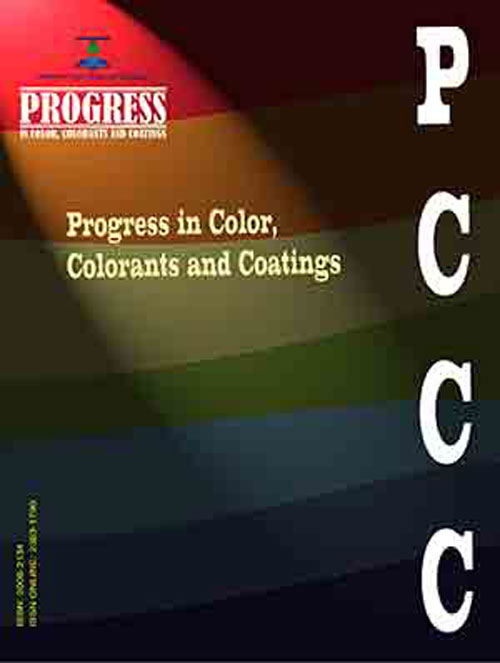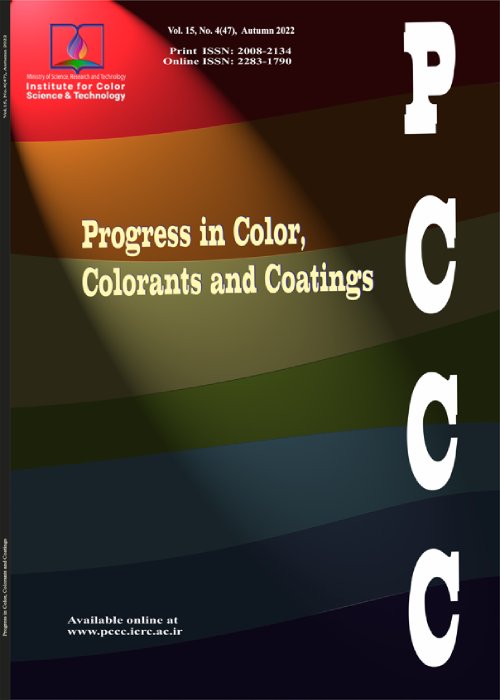فهرست مطالب

Progress in Color, Colorants and Coatings
Volume:10 Issue: 3, Summer 2017
- تاریخ انتشار: 1396/07/25
- تعداد عناوین: 6
-
-
Page 141Green nano pigments of Cr2O3 and CoCr2O4 were successfully prepared by polyol method followed by calcination at 770°C. The Cr2O3 and CoCr2O4 samples were characterized by X-ray diffraction XRD, scanning electron microscopy SEM, diffuse reflectance spectroscopy DRS, dynamic light scattering DLS, UVVis spectroscopy and CIE-Lab colorimetry methods. Dynamic light scattering analysis confirmed the formation of nanoparticles in suspensions. XRD data of Cr2O3 and CoCr2O4 powders displayed the formation of crystallized rhombohedral and spinel structures, respectively. The average crystallite size of Cr2O3 and CoCr2O4 are calculated ~54 and 39 nm, respectively. The SEM results showed the average size of Cr2O3 and CoCr2O4 nano pigments is about 70-80 nm, while CoCr2O4 nano pigments were more agglomerated than Cr2O3. The calorimetric and DRS data confirmed the formation of green pigments in both samples.Keywords: Polyol method, Green pigment, Cr2O3, CoCr2O4
-
Page 149The current essay analyzes the anti-corrosion properties of epoxy primers including anti-corrosion pigment calcium hydrogen orthophosphate and hydrophobic nano silica with various percentages optimized by Taguchi experimental design. The impact of influential factors such as the percentage of anti-corrosion pigments, percentage of nano silica and pigment to binder ratio on anti-corrosion properties of epoxy primer based on model L9 Taguchi method was considered and analyzed. The anti-corrosion pigments and nano silica were initially dispersed into epoxy resin, the samples for corrosion testing were practiced on metal panels. Furthermore, a main sample is identified to be compared with the samples chosen by Taguchi experimental method. Electrochemical impedance spectroscopy (EIS) is applied to study the corrosion inhibition performance of the primers in 3.5% NaCl aqueous solution and salt spray test. To figure out the distribution of nano silica, particles in epoxy resin were detected by scanning electron microscope (SEM). The outcomes achieved in this work revealed that solubility of pigment and corrosion inhibition are significant factors influencing corrosion resistance of the epoxy primer. Generally, it is proved that adding nano silica to epoxy primer made the number of blisters and corrosion products diminish after being exposed to corrosion test. The most appropriate results of the corrosion resistance tests presented in the sample embracing the epoxy primer loaded with 6.5% calcium hydrogen orthophosphate, 3% nano silica and pigment to binder ratio of 1.Keywords: Epoxy coatings, Taguchi, Anti corrosion pigments, EIS, SEM
-
Page 163This paper presents the results of absorption spectra, fluorescence properties and the effect of solvents on UV-Vis spectra of dye quaternized 4-acetylamino-N-2-aminomethylpyridine-1,8-naphthalimide. The fluorescency of the dye was evaluated and its Stokes shift value was 6140 cm-1 in DMF. The solvatochromism behavior of the novel compound is investigated by studying its spectra in pure organic solvents of different characteristics. The factors that affect solvatochromism are discussed like solvent polarity. Finally, the fluorescent dye was applied on polyamide fabrics in order to investigate its dyeing properties. Wash, light, and rubbing fastnesses of the dyed fabrics were measured by standard methods. Moreover, the build-up properties of the synthesized dye was measured on polyamide fabrics. Dyed polyamides had very good wash and rubbing fastness degrees and moderate light fastness. The antibacterial activity of the dyed fabrics was evaluated.Keywords: Absorption spectra Fluorescence properties, Solvatochromism effect, Dyeing properties, Quaternary ammonium
-
Page 173The application of heterogeneous photocatalysis in industrial scale has been hindered by a lack of simple mathematical models that can be easily applied to reactor design and scale-up. This work intends to use a simple mathematical model for predicting methylene blue (MB) degradation in a slurry-annular photocatalytic reactor using zinc oxide (ZnO) hybridized with reduced graphene oxide (rGO)-ZnO composite. The mathematical model presented may be used as a tool to design, scale-up, and optimize annular photocatalytic reactors for water and wastewater treatment. A mathematical model for the photocatalytic degradation of MB with rGO-ZnO under UV light irradiation was developed. This model was achieved by combination of LangmuirHinshelwood kinetics and LambertBeer law. The accuracy of developed model was checked for predicting MB degradation in other operation conditions such as different photocatalyst dosage and initial MB concentration. On the basis of these results, the accuracy of the model was tested under different experimental conditions, resulting able to be predictive in different operating conditions.Keywords: Methylene blue degradation, Graphene-hybridized ZnO, Photoreactor design, scale-up, Mathematical modelling
-
Page 181In this research, ZnO nanoparticles modified with imidazole in O-xylene solution and characterized with Fourier transform infrared FTIR spectroscopy. Then, polyaniline-ZnO unmodified and imidazole modified nanocomposites were synthesized via in-situ emulsion polymerization method. The synthesized nanocomposites were characterized by FTIR and scanning electron microscopy SEM. The anti-corrosion behavior of the epoxy coating in the presence of unmodified ZnO, imidazole modified ZnO, polyaniline-ZnO unmodified and imidazole modified were studied in NaCl 3.5 wt solution at 65 ℃ for 100 h by electrochemical impedance spectroscopy EIS. The coating resistance Rcoat of epoxy coating containing unmodified ZnO, imidazole modified ZnO, polyaniline/ unmodified ZnO and polyaniline/ imidazole modified ZnO after 100 h immersion in saline electrolyte found to be 7.2×104 , 1.3×105 , 2.3×105 and 1.7×107 Ω cm2, respectively. It can be seen that polyaniline/ imidazole modified ZnO nanocomposite exhibited higher corrosion resistance and provided better barrier properties against ingress of corrosive electrolyte.Keywords: Anticorrosion resin, Barrier performance, Conductive polymer, EIS, Nanopigments
-
Page 193In this study, UV-curable urethane acrylate UA synthesized and then characterized by FTIR and HNMR. For better dispersion of nanoparticles in polymeric matrix, nano Al2O3 was modified by silane coupling agent and then its nanocomposites were prepared. The characteristics of synthesized nanocomposites were analyzed by TGA, DMA and infrared thermography. The results signify that adding nano Al2O3 to UA matrix leads to improvement of thermal stability and viscoelastic properties of the nanocomposite. Infrared thermography analysis shows that adding Al2O3 to UA causes the surface reflection coefficient to increase and the heat transfer of UA nanocomposites to reduce. Therefor one could point that UA/Al2O3 3 and 5 wt is a thermal barrier as a heat insulator.Keywords: Urethane acrylate, Nanocomposite, Nano aluminum oxide, Viscoelastic properties, Thermal conductivity


